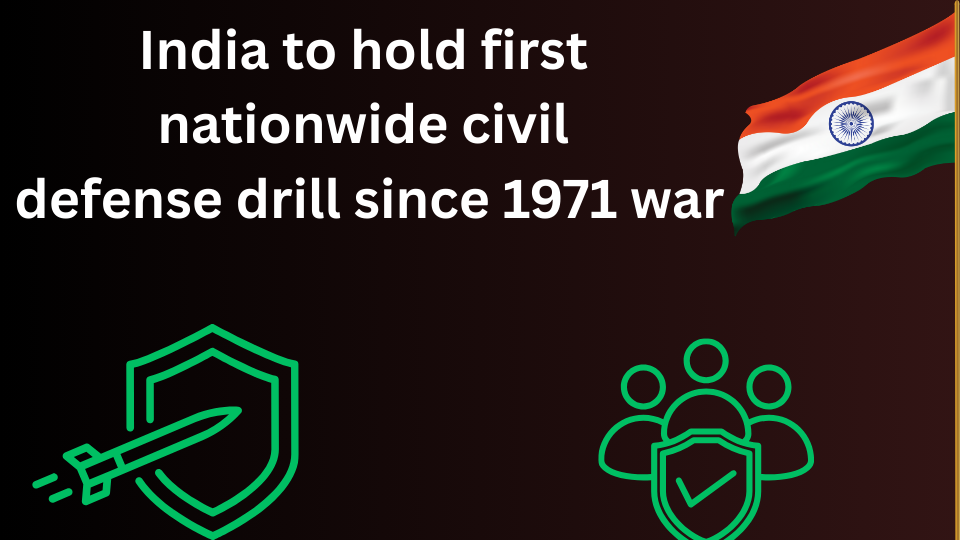In an unprecedented move, the Indian government has announced plans to conduct a massive civil defense drill across multiple states on May 7. This marks the first such nationwide drill since the 1971 Indo-Pak War, signaling a renewed focus on civilian preparedness amid growing regional security challenges. The move comes amid escalating tensions with Pakistan following recent terrorist attacks and heightened military activity along the Line of Control (LoC).
The Ministry of Home Affairs (MHA), under Amit Shah, has told multiple states to conduct this civil defense drill.
Key points

Why this civil defense drill matters now?
The decision comes at a time when India faces complex security threats, from drone incursions to potential missile attacks. What makes this exercise historic is its scale – something not seen even during the 1999 Kargil conflict.
“We’re not just preparing our armed forces anymore,” explains former Brigadier Rajeev Sharma. “After seeing how Ukraine’s civilian preparedness saved lives during Russian attacks, our government realizes ordinary citizens need to be part of national defense.”
What will the drill involve?
Air Raid Sirens
Cities will test warning systems similar to those used in Ukraine, where sirens give civilians 90 seconds to find shelter.
Blackout Drills
Residents will practice turning off lights – a tactic India successfully used in 1971 when Pakistani pilots struggled to locate targets in darkened cities.
Critical infrastructure protection
Officials will demonstrate how vital installations like power plants might be camouflaged, just as the Taj Mahal was covered with green netting during the ’71 war.
States on high alert
While the Home Ministry hasn’t released the full list, security analysts predict these regions will participate:
- Border States: Jammu & Kashmir, Punjab, Rajasthan
- Strategic Cities: Delhi, Mumbai, Bengaluru
- Industrial Hubs: Gujarat, Maharashtra
“Coastal states may join later phases,” says defense analyst Priya Menon. “But right now, the focus is on areas most vulnerable to aerial threats.”
What civilians need to now?
- Loud sirens between 10 AM-12 PM
- Temporary traffic restrictions near government buildings
- SMS alerts with safety instructions
- Volunteer wardens guiding people to designated shelters
The social media challenge
Authorities are particularly concerned about misinformation during emergencies. Recent reports show some Indian influencers receiving funding from Pakistani sources.
“We’ve seen fake evacuation orders cause stampedes elsewhere,” notes cyber security expert Amit Dubey. “This drill will test our ability to maintain clear official communication channels.”
Citizen responsibilities
The government emphasizes that this isn’t just an official exercise – every resident has a role:
- Learn your local shelter locations
- Bookmark official alert websites
- Prepare emergency kits with water, medicines, and batteries
As retired Colonel Virender Singh puts it: “In 1971, shopkeepers voluntarily blacked out marketplaces. That’s the spirit we need to revive.”
Political consensus emerges
In a rare show of unity, PM Modi has briefed opposition leaders about the drill’s importance. This bipartisan approach mirrors wartime protocols, suggesting the government views current threats with utmost seriousness.
What comes next?
After May 7, states will submit readiness reports to the Home Ministry. Many expect these drills to become quarterly events, much like earthquake preparedness exercises in Japan.
For now, the message is clear: India’s security isn’t just about soldiers at borders – it’s about teachers, shopkeepers, and students knowing how to respond if crisis comes.
The Pakistan factor
Multiple sources confirm Pakistan’s military is closely monitoring these preparations. What’s particularly telling is that while India conducts these drills, Pakistan faces severe ammunition shortages. Defense analyst Major General (Retd.) G.D. Bakshi revealed: “Their artillery reserves would last barely four days in sustained conflict.”